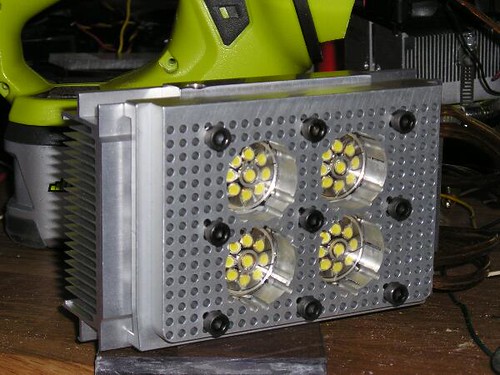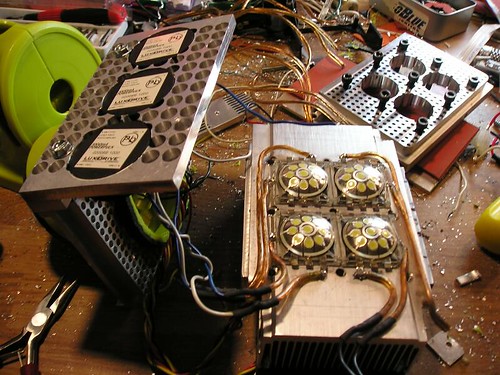Hey there. You have a very nice build there. I was just wondering, but is that light even practical? I am a power junky myself, but when I thing emergency light, I think efficiency. I guess I do not know what your requirements are during a power outage, but I thought just several hundred lumens of light would be sufficient to light up a medium sized room comfortably. I have personally worked with LED arrays that output everything between 1000 lumens to over 4000 lumens, and sometimes that seems plain excessive for living casually with (reading a book, sitting at the couch, etc). It would be great if used while working at the workbench messing with electronics or flashlights, though. It would also be wonderful to work as a lantern to light up a large area while camping. I think that if you match the lumen output (at most) of whatever lamp used during the times you have power would make much sense. Most bulbs list the typical lumen output on its packaging, or you can search the internet for an estimated lumen output (Wikipedia was useful to me). Your rig looks impressive, and it looks like something you would show off.
Anyway, it would be best to test heatsink temperatures with the fans turned on and off. It is difficult to tell you how to set up your fans without this info. Keep in mind the properties of the LED emitters that you have chosen. Check out the datasheets to see what the maximum operating temperatures are (avoid these high temps), as well as find how the efficiency and life is affected by elevated temps. You will have to compromise efficiency and life with runtime and other factors (like noise or complexity). Maybe you will not need the fans to run at full speed to keep the heatsink at a certain temperature, or they may not need to kick in for a while. Maybe you can extend the runtimes by lowering the current to the emitters. Emitter efficiency increases as the current decreases. So, as you deliver more current, the efficiency will naturally drop. In addition, as the temps increase, the output will degrade a bit. The trick is finding that sweet spot. The datasheets will help you finding that compromise.
One of the LED clusters I have is mounted directly to a copper plate to spread the heat, then this copper plate is bolted to a massive extruded heatsink (using a bit of thermal paste between the two metal surfaces). Finally, I added some of those temperature sensing CPU cooling fans to regulate temperatures as everything warms up. Some of these cooling fans have external thermistors you can attach to the heatsink to monitor temperatures, and they will automatically regulate the temperature. However, the temperatures will only be properly regulated if the fans can even move the correct amount of air to remove the heat. In my case, the old and inefficient emitters produced way too much heat than my massive heatsink and basic temperature sensitive Thermaltake fan (80mm^2 size) could handle, so after a few minutes, the fan is at full speed and the temps still rise. The thermistor placement affected how quickly the speed increased. I wish I knew the fan speed vs. temp curve for those fans. Anyways, you may have better luck than me since you have two fans in your array for 40W max, while I had one fan for LEDs consuming 60-100W.
Play with the sweet spot first (compromise output versus runtime considering efficiency and heat), then try to cool it next. With a 40W load, you should be able to regulate temps with the fans with your massive heatsink as long as the surface area of the heatsink is sufficient as well as the airflow is unrestricted. You have an untested custom lantern, so trial and error will get you that perfect emergency light! I wish I could help you with circuitry that will automatically dim as temps reach a critical level (which can be fixed using the correct LED current levels from the start and fan selection) or the battery capacity drops.
I hope I am being helpful. If you want the model of the fans I used, I can find it for you. I havent read your every word in your thread, so I probably missed some details. Sorry for that.

Cheers,
-Tony








